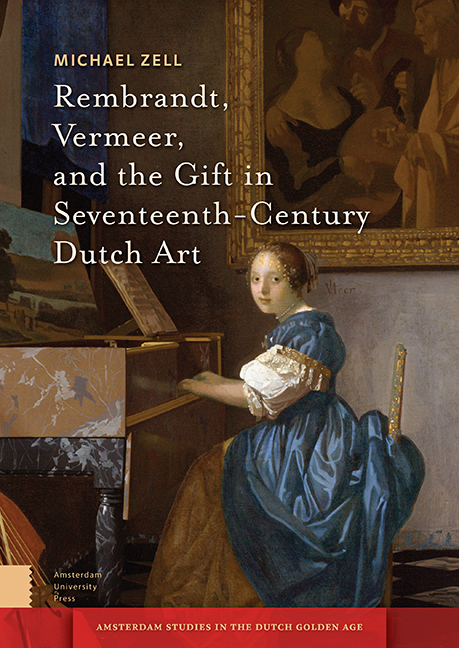Book contents
- Frontmatter
- Dedication
- Contents
- Illustrations
- Acknowledgments
- Introduction
- 1 The Gift and Art in Early Modernity
- 2 Art as Gift in the Dutch Republic
- 3 Rembrandt’s Art as Gift
- 4 Art and Leisure: Amateur Artists, Rembrandt, and Landscape Representation
- 5 For the Love of Art: Vermeer and the Poetics of the Gift
- Conclusion
- Bibliography
- Index
3 - Rembrandt’s Art as Gift
Published online by Cambridge University Press: 21 October 2021
- Frontmatter
- Dedication
- Contents
- Illustrations
- Acknowledgments
- Introduction
- 1 The Gift and Art in Early Modernity
- 2 Art as Gift in the Dutch Republic
- 3 Rembrandt’s Art as Gift
- 4 Art and Leisure: Amateur Artists, Rembrandt, and Landscape Representation
- 5 For the Love of Art: Vermeer and the Poetics of the Gift
- Conclusion
- Bibliography
- Index
Summary
Abstract
This chapter examines Rembrandt's embrace of gift exchange over his career and analyzes the works he created to function as gifts among favored patrons, collectors, and intimates. Rembrandt's gifts to important patrons and other figures in the 1630s largely conform to the conventions and courtesies expected of gift transactions. From the late 1640s through the 1660s, as Rembrandt's primary supporters shifted to liefhebbers, gentlemen-dealers, and cultured members of the burgher class, however, he intensified his engagement and became more experimental with gift giving. Through highly distinctive prints designed to circulate as gifts, Rembrandt enlisted the gift economy to nurture ties with his inner sanctum, harnessing the ethics of gift giving to cultivate a unique position in the Dutch art world.
Keywords: Rembrandt; Gifts; Gift Giving; Economics of Art; Art and Money
Throughout his career, Rembrandt presented gifts of his art to patrons, collectors, and familiars. Beginning in the 1630s, as he was actively courting prominent patrons in The Hague and Amsterdam, Rembrandt's gifts adhered to the protocols of gift giving at the stadholder's court and among Dutch urban elites. But in the later 1640s through the 1660s – when his audience was largely comprised of art lovers, gentlemen-dealers, and poets of the well-to-do burgher class with whom he maintained close relations – Rembrandt creatively engaged the symbolic economy of the gift in the design and distribution of his art, even creating distinctive works to function within a context of gift exchange. This chapter charts the changing pattern of Rembrandt's gifts of art and elucidates the interrelationships of his gifts, his documented obstinacy with patrons, and his demand for elevated compensation as demonstrations of the artistic persona he fashioned for himself. Rembrandt’s increasing focus on gift transactions in later years and his creative adaptation of the gift system for his artistic purposes reveal how this aestheticized form of exchange became an alternate means of promoting his work's artistic and social value. While gift giving served as one of the multiple strategies available to Dutch artists to market and distribute their work, for Rembrandt the symbolic power of the gift also functioned as a resource to cultivate a privileged status for both himself and his art. The unusual intimacy of address characteristic of Rembrandt's later prints also evolved partly through his engagement of the gift economy to nurture an audience of liefhebbers, endowing his art in the process with compelling agency to mediate cultural and social identities.
- Type
- Chapter
- Information
- Publisher: Amsterdam University PressPrint publication year: 2021



